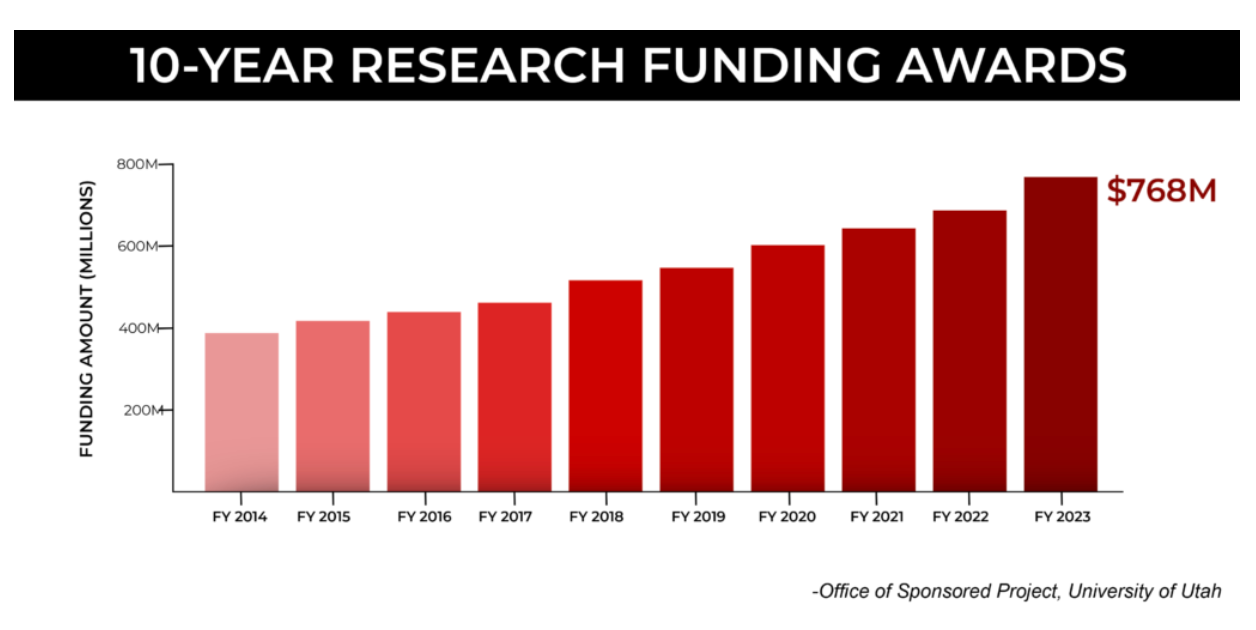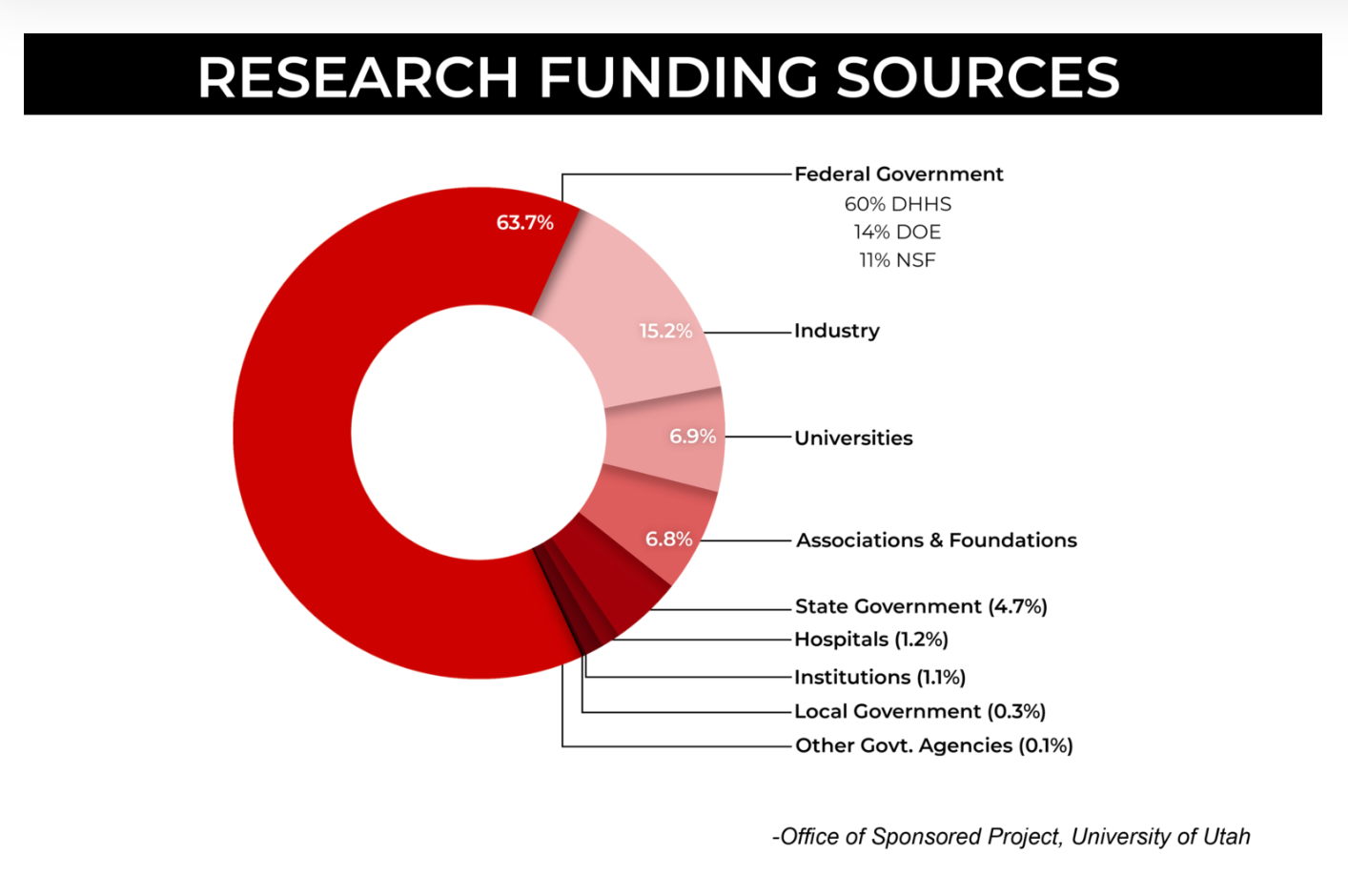At $768 Million in Research Funding for Fiscal 2023, the University of Utah Sets a New Funding Record

From a base of $388.5 million in FY 2014, researchers at the UofU have snagged nearly $5.5 billion in total research funding over the past decade, nearly doubling annual research monies in just 10 years
At $768 million, the University of Utah has just set a new record for total amount of funding its researchers have received in one fiscal year.
According to this week's announcement from the Office of the Vice President for Research at the UofU, researchers at the state's oldest institution of higher education have now seen increased research funding each year for the past 10 years.

According to annual data obtained by Utah Money Watch from the UofU's Office of the Vice President for Research, UofU researchers have raised nearly $5.5 billion during the past decade (as shown below).
- FY 2023: $768 million,
- FY 2022: $688 million,
- FY 2021: $644 million,
- FY 2020: $603 million,
- FY 2019: $551 million,
- FY 2018: $517.5 million,
- FY 2017: $459 million,
- FY 2016: $439.5 million,
- FY 2015: $423.5 million, and
- FY 2014: $388.5 million.
In case you're counting, that's $5,482,000,000 (aka, $5.482 billion)!
“The University of Utah is a top Research 1 (R1) institution, and our achievements both in the past and present reflect that,” said Dr. Erin Rothwell, vice president for research for TheU. “To see that our research funding has hit another record year is a testament to our students, faculty, staff and community partners’ commitment to bringing solutions to the societal issues of today and tomorrow.”
Classifying R1, R2, and R3 Research Universities
Initially defined in 1970 by the Carnegie Foundation, the Research 1 (R1) and Research 2 (R2) university classification system has been overseen by the Center for Postsecondary Research at Indiana University Bloomington since 2014.
R1 institutions are defined as doctoral universities with very high research activity; conversely, R2 institutions are defined as doctoral universities with high research activity. {NOTE: For greater detail on the distinctions between R1, R2, and R3 institions, you might turn to this Wikipedia page which I found to be the most consise yet comprehensive overview of the university classification system.}
Today, 146 universities in the United States are classified as R1 insitutions, ranging from Arizona State University to Yale University.
Conversely, there are 133 R2 institution in the U.S. today, ranging from the Air Force Institute of Technology Graduate School of Engineering & Management to Wright State University.
For what it's worth, the state of Utah has two R1 universities today:
- The University of Utah (since at least 2004), and
- Utah State University (most recently since December 2021*).
Additionally, my alma mater — Brigham Young University — is classified as an R2 university, which is not bad, especially since BYU is unadbashedly a teaching institution first and foremost.
Research Funding Success (and Sources) in Utah
According to the UofU, of the $768 million total in research funding raised by the UofU in FY2023, $487 million was provided by various federal government (and private) sources, with the three most significant U.S. government funding sources being the
- National Institutes of Health: $291 million,
- United States Department of Energy: $69 million, and the
- National Science Foundation: $55 million.

Both USU and BYU disclose their research funding data on a calendar year basis (ended December 31), so a direct comparison with the UofU is not truly possible.
However, the 2022 Annual Report of the Office of Research at USU published that researchers at Utah State pulled in over $390 million in research funding in 2022.
Of that total, 59% is attributable to funding of USU's Space Dynamics Laboratory or $230.4 million.
By contrast, BYU's 2022 Annual Report of Sponsored Research shows that it pulled in a modest $39.4 million in sponsored research funding in FY 2022. Of that total, 82% comes from federal sources.
Taken in concert, when you total the combined amounts of monies raised, it turns out these three leading research institutions in Utah — the University of Utah, Utah State University, and Brigham Young University — collected nearly $1.2 billion in total research funding over the past year.
Out of that ~$1.2 billion in combined research funding,
- The UofU produced 64.1% of the total ($768 million),
- USU produced 32.6% of the total ($390 million), and
- BYU produced 3.3% of the total ($39.4 million).
Utah's Top 3 research universities — the UofU, USU, & BYU — collected nearly $1.2 billion in combined total research funding over the past year.
So kudos to all three universities, their researchers, staff, and administrators.
* — Apparently USU was previously classified as an R1 university some 20 years ago, roughly in the 2000—2002 time frame. Unfortunately, I was unable to ascertain why its R1 status was removed or how long it had been an R1 institution before its classification was lowered near the beginning of the century.




Comments ()